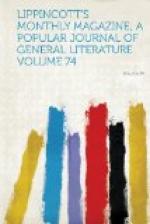We had an easy ride the next morning to Nazareth, and a kindly reception from the monks. The hospitality at all these convents is untrammelled by pecuniary conditions; but all travellers who have purses and hearts and consciences do, in fact, on their departure, present the Superior with a sum about equal to the charges for the same length of time at an Eastern hotel. I mention this in the interests of historic truth, and not with any desire to throw a garish light of self-interest upon the cordiality of these Latin “religious.” We were in the heart of the little city where He whom millions of human beings call their Saviour and God lived for more than twenty years. Somewhere among these houses that fill the valley and cling to the hill-side was Joseph’s home. Not a house, of course, is here now that was here then; all the sacred places they show you—the Virgin’s home, the place of the Annunciation, the workshop of Joseph—must be unauthentic; but these hills are what they were. They shut out the great world He had come to redeem, but not the heavens above Him or the sinfulness and needs of the segment of humanity around Him. When we rode toward Tiberias in the early morning there were a dozen or more of the girls of Nazareth going out to Mary’s spring, as the fountain at the entrance of the town is called; but their garments were ragged and uncleanly and their swarthy faces heavily tattooed, and, while we were ready to accept the season of the year as an excuse for any deficiency in the attractiveness of the landscape, we could not admit it in extenuation of the uncomeliness of the maidens of Palestine. Their beauty we believe to be almost entirely a fiction of the tourist’s imagination.




